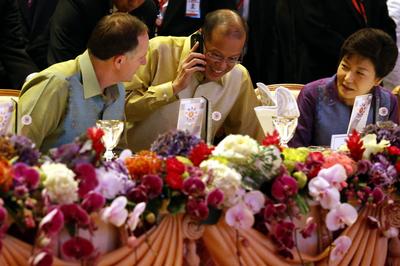The AEC’s vision includes four key pillars: a single market and production base, a highly competitive economic position, equitable economic development and full integration into the global economy. In particular, the AEC aims to establish a regulatory framework that allows the free movement of goods, services, investment and skilled labour among member countries. Much has already been done towards this goal. Brunei, Indonesia, Malaysia, the Philippines, Singapore and Thailand have eliminated tariffs on 99.6 per cent of goods since the creation of the ASEAN Free Trade Area, while Cambodia, Laos, Myanmar and Vietnam have reduced their tariffs to between 0 and 5 per cent for 98.6 per cent of goods. As announced at the ASEAN ministerial meeting in Brunei in August 2013, 79.7 per cent of items in the AEC Blueprint have already been implemented.
Despite this progress, the timely realisation of the AEC remains a formidable goal. For example, while it is easy to remove tariff barriers, it is much harder to remove non-tariff barriers. According to some high-ranking government officials, it may be more realistic for ASEAN to extend the AEC vision beyond 2015, possibly to 2025, rather than deal with this politically sensitive issue.
Furthermore, the outcome of current economic integration efforts remains mixed, as evident from member-to-member trade data. From 2000 to 2010, the share of intra-regional trade in ASEAN’s total trade activity increased by only 1.7 percentage points, from 21.9 per cent in 2000 to 23.6 per cent in 2010. This is comparable to India’s increased share of ASEAN trade over the same period, from 1.2 per cent in 2000 to 2.9 per cent in 2010. In contrast, China’s share of ASEAN trade rose by 7.8 percentage points, from 4.4 per cent in 2000 to 12.2 per cent in 2010. And for individual member countries there was not necessarily a great deal of change. For example, ASEAN’s share in total Vietnamese trade shrank from 23 per cent in 2000 to 16.7 per cent in 2010, while there was only a modest expansion over the same period for Cambodia (22.5 per cent to 22.7 per cent) and Singapore (25.9 per cent to 27.4 per cent).
Given the daunting challenges that ASEAN countries must overcome to realise the AEC vision, it is imperative that ASEAN leaders go beyond the current approach, which is mainly focused on reducing barriers and building infrastructure connectivity. They must foster regional economic integration by focusing not only on freer movement of goods and capital but also on a much higher level of collaboration. In pursuit of this strategy, the AEC’s current vision and its four pillars should be strengthened with a fifth pillar: building ASEAN into a learning community.
Developing this pillar requires both a collective and individual effort by ASEAN members to vigorously improve institutional knowledge and performance. This can be achieved through benchmarking and experimentation and by exploiting ASEAN’s latecomer advantage.
The learning community approach is strategically important for ASEAN in three ways. First, it can help ASEAN turn the development gap among members into a source of motivation to experiment with new ideas and implement change. Second, ASEAN can learn a great deal from the European Union about economic integration. This includes policy development and institution building. In particular, the European Union’s ‘open method of coordination’, in which countries share information on best practices and use gentle peer pressure to encourage improvement, is an effective approach that ASEAN could adopt. Learning from EU experiences could also help ASEAN produce quick but sustainable results that leverage the momentum for deeper regional integration. For example, if ASEAN were to adopt the European Union’s concept of a ‘single sky’, it is estimated that Vietnam alone could save more than one hundred million dollars and hundreds of thousands of flight hours annually by having direct routes for domestic flights through Laotian and Cambodian airspace.
Third, by emphasising a learning community while implementing regional integration, the ASEAN Secretariat would ameliorate the learning capabilities of the bloc and its member countries. With this focus, it is imperative that the ASEAN Secretariat develop a database that provides robust and timely data on economic conditions, performance and reform initiatives among member countries, along with a comprehensive set of international best practices, especially from the European Union, to deepen economic and institutional integration.
Transforming ASEAN into a robust economic community requires from member leaders not only stronger determination and deeper commitment but also a new strategy to make the regional integration process more vibrant, productive, collaborative and beneficial. To develop this strategy, ASEAN should not ignore the opportunity to build a robust, dynamic learning community.
Vu Minh Khuong is an Assistant Professor at the Lee Kuan Yew School of Public Policy, National University of Singapore.
Kris Hartley is a PhD student at the Lee Kuan Yew School of Public Policy, National University of Singapore.

